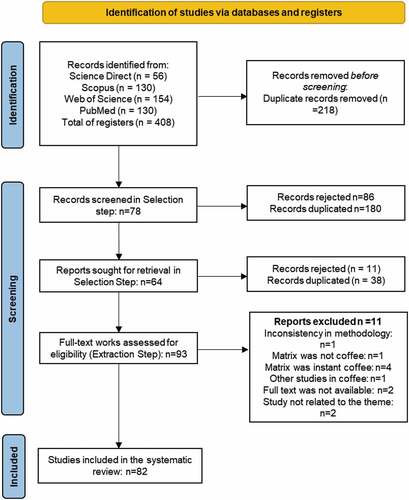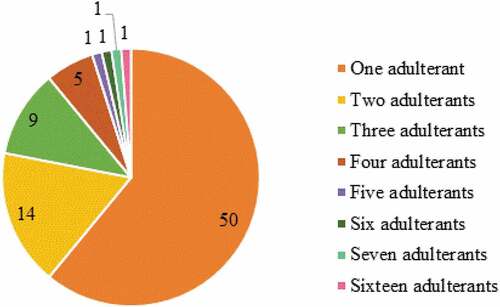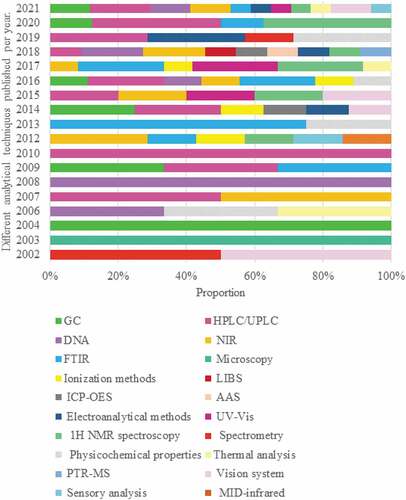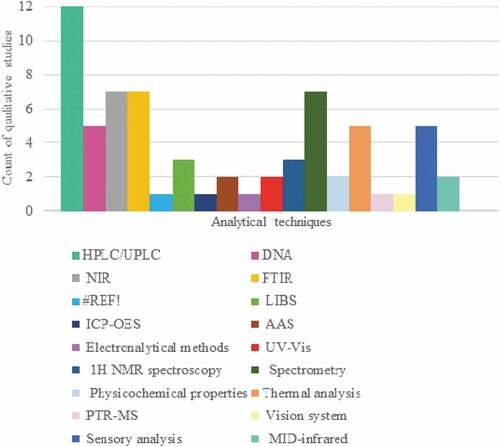ABSTRACT
The presence of impurities in roasted ground coffee interferes with its quality. This Systematic Literature Review (SLR) aimed to identify and evaluate the different types of analytical techniques published in the last 20 years for the detection of adulterants in roasted coffee. The SLR was performed on StArt software in three stages: Planning, Executing, and Summarization. Eighty-three studies were selected for this review. The type of coffee most frequently studied was roasted ground coffee and Coffea arabica, while among the adulterants, Coffea canephora, coffee wastes, and corn. There was a trend toward applications of chromatographic, spectroscopic, and multi-adulterant techniques. Suitable techniques to detect/quantify adulterations in coffee and particularly as multi-detection approaches are crucial to improve coffee quality worldwide.
Introduction
Coffee is one of the most consumed beverages in the world, with a global production of 179 million bags of 60 kg in 2020, according to data from the International Coffee Organization (ICO). Brazil is the main producer and exporter of coffee in the world, being responsible for more than 37% of all coffee production in 2020. Vietnam stands out as the second-largest coffee producer, with 17%, followed by Colombia, with an estimated contribution of 8.4% .[Citation1]
The main species produced and exported in the world are Coffea arabica (Arabica coffee) and C. Canephora (Robusta coffee). Arabica accounts for about 59% of worldwide production, while the species C. canephora had an estimated production of 41% in 2020 .[Citation1] In general, Arabica coffee has an aroma and flavor superior to Robusta coffee, being commercially more valued .[Citation2] The roasted and ground coffees sold worldwide have different proportions of Arabica and Robusta species, with each brand producing its typical blends (mixture), with the appropriate characteristics for the consumer market .[Citation3]
However, due to its high commercial value, coffee is constantly the target of fraudulent actions. The presence of impurities and mixtures in the roasted and ground coffee powder interferes with the quality of the beverage, which in addition to the pleasant taste and aroma is also known to contain important micronutrients with health appeals, such as antioxidants and phenolic compounds (mainly chlorogenic acids) .[Citation4,Citation5]
In Brazil, for example, the most frequently adulterants added to roasted and ground coffee are coffee husks and sticks, corn, barley, brown sugar, and soy. Recently, new plant species are being used as adulterant, namely açai and triticale .[Citation4,Citation6,Citation7] These foods have less added value than coffee and a lot of similarities (particle size, texture, and color) when roasted and ground, which makes their visual detection by regulatory agencies increasingly difficult .[Citation8]
Regarding the current legislation in Brazil, the Resolution of the Collegiate Board of Directors (RDC) no. 623 of March 16, 2022, establishes the assessment of macro and microscopic extraneous materials in foods and beverages, including coffee. This RDC adopts the AOAC analytical methodology or equivalent as its official method, which consists of microscopy and visual analysis .[Citation9,Citation10] However, the Brazilian Coffee Industry Association (ABIC), which represents the coffee roasting and grinding industries across Brazil, implemented inside of the Permanent Coffee Purity Control Program (PPCPC) the blind analysis of the samples according to the microscopic method established by Adolfo Lutz Institute .[Citation11] This technique consists of the detection of impurities and foreign matter in the coffee carried out by visual analysis of roasted and ground coffee on microscopic slides with the aid of a stereoscopic microscope. The limitations of this technique are that it is time-consuming and costly, in addition to the fact that the use of chemical reagents, such as chloroform, destroys the sample. Furthermore, this analysis depends on the analyst’s experience, which makes the method subjective and with low reliability of the results. .[Citation12]
Despite the economic gain caused by intentional fraud, this issue can also represent a risk to food safety, since the absence of accurate nutritional information in the labeling might expose the consumer to food allergens .[Citation13] Thus, the availability of more specific and sensitive analytical methods to analyze the quality of roasted and ground coffee can support food analysis laboratories and regulatory agencies concerning compliance with legislation and it is essential for not compromising human health. Among the adulteration detection techniques, the most current and promising are Near Infrared Spectrometry, Gas Chromatography-Mass Spectrometry, real-time Polymerase Chain Reaction, and High-Performance Liquid Chromatography.
Some review papers on coffee adulteration have already been published, highlighting the work by Toci, Farah[Citation14] in 2016 whose review evidenced the research of adulteration in coffee, but included only 30 articles in their discussion. The review published in 2017 by Burns, Tweed[Citation15] focused on adulteration by geographic origin, using coffee species and adulteration by dilution, and only on roasted and ground coffee. Wang, Lim,[Citation16] in 2020, following this theme, directed their review to coffee brew. Due to the restriction of criteria in the selection of studies in the literature reviews so far, there is a commitment to the evaluation of research trends in the area of adulteration in coffee, thus requiring systematic research on this topic. To date, there is no systematic review applied to the evaluation of techniques used in the investigation of adulteration in roasted coffee. Thus, this systematic review aims to identify and evaluate applications and trends of analytical methods and techniques used in the detection and quantification of adulterants in roasted coffee applied in the last 20 years.
Materials and methods
Different virtual platforms are available to assist scientific research with different objectives, such as storing data from scientific studies as well as making the search for studies reproducible (Web of Science, PubMed, Scopus), managing the bibliography of scientific papers (Mendeley, EndNote, Zotero), statistically analyzing research results (Excel, R, Stata, Assistant, Stat Plus), managing and systematizing the process of each step of the systematic review and/or meta-analysis (Cochrane, Rayyan, STATA®, Meta-essentials).
Thus, as an instrumental tool for performing the Systematic Literature Review (SLR), the State of the Art through Systematic Review software (StArt) version 3.0.3 BETA was used, which was developed by the Software Engineering Research Laboratory (LaPES), of the Computer Science Department of the Federal University of São Carlos (UFSCar) (LaPES, 2012). This software provides well-defined support for all steps of the SLR, namely planning, execution, and summarization of scientific studies. This review process was performed as described below.
Planning
The planning stage consists of the definition and filling of all steps included in the search protocol in the software itself, which supports the entire search process, selection, and data extraction. All steps are described below:
Objective
Identify and evaluate applications of analytical methods and techniques used in the detection and quantification of adulterants in roasted coffee over the past 20 years.
Main question
What are the methods and techniques used to detect adulteration in roasted coffee?
Use PICOC (Population, Intervention, Comparison, Outcomes, and Context) criteria
Population
Analytical techniques and methods for detecting adulteration in roasted coffee.
Intervention
How the application of analytical methods and techniques was used in the detection and quantification of adulterants in roasted coffee.
Control
Collection of scientific articles and short communications on methods and analytical techniques used in the detection and quantification of adulterants in roasted coffee obtained from scientific databases available on the Internet.
Outcomes (results)
Studies that address analytical methods and techniques for the detection of adulterants in roasted coffee, as well as possible public health concerns related to the consumption of adulterated roasted coffee.
Context (application)
Projects and studies involving the study of the quality and authenticity of roasted coffee.
Keywords and synonyms
adulteración café, adulteração café, coffee adulteration, coffee fraud, fraude café
Source selection criteria definition
Criterion
Works indexed in journals in the field of Food Science and Technology available in web database; Works after the year 2000.
Studies languages
English, Portuguese and Spanish
Sources search methods
Read the title, abstract, and keywords of the documents.
Source list: source,
Science Direct, Scopus, Web of Science, and PubMed.
Study selection criteria
Inclusion criteria
Studies with adulterated coffee that contain data on methods of analysis of adulterants in coffee; articles that discuss adulterated coffees with different food matrices; articles that mention coffee adulterated with other types of coffee; adulteration with coffee by-products and cultural remains of coffee; adulteration by geographical designation or origin of coffee; studies containing data from the analysis of chemical and/or nutritional composition in adulterated coffee; studies with adulterated coffee containing sensory analysis, consumer perception; studies with adulterated coffee that contain analysis of public health and consumption of adulterated coffee; adulteration with drugs or other chemical substances in coffee.
Exclusion criteria
Other studies on coffee; studies only with green coffee; studies with soluble coffee; articles in a mixed drink; review studies; studies that are not about coffee adulteration.
Studies type definition
Original articles and short communications made with roasted coffee were considered, as well as qualitative and quantitative studies.
Studies initial selection
An initial assessment through the reading of the title, abstract, and keywords was carried out for the application of inclusion and exclusion criteria. The full text document was accessed in cases where previous analyzes proved inconclusive for selection. Studies presented as accepted, rejected, or duplicated status.
Studies quality evaluation
Not applicable.
Quality Form Field: impact factor = ≥0.4
Data extraction form fields
reading the complete document for data extraction. A careful evaluation of the quality of the documents was carried out based on the analysis of the methodology of the works retrieved and accepted Supplementary Data (Table S1).
Results summarization
After the complete reading of the chosen works, a technical report was prepared with a quantitative analysis of them. A qualitative analysis was also carried out to report possible results of techniques used to characterize samples of coffee and adulterants, such as antioxidant analysis, physical-chemical analysis, and color analysis, among others. The limitations and suggestions for future research were placed in a separate section. The report may contain both discursive and tabulated summaries.
Execution
After completing the Protocol, the Execution stage was carried out.
Studies Identification: the search strings were applied to each database, as described below, and the results were exported in BibTex format. to StArt:
a) Science Direct: Title, abstract, keywords: (coffee) AND (adulteration OR fraud).
b) Scopus: (TITLE-ABS-KEY (coffee) AND TITLE-ABS-KEY (adulteration OR fraud) AND PUBYEAR > 1989 AND (LIMIT-TO (DOCTYPE,”ar”)) AND (LIMIT-TO (LANGUAGE,”English”) OR LIMIT-TO (LANGUAGE,”Portuguese”) OR LIMIT-TO (LANGUAGE,”Spanish”).
c) Web of Science: TOPIC: (coffee) AND TOPIC: (adulteration OR fraud). Refined by: DOCUMENT TYPES: (ARTICLE) AND LANGUAGES: (ENGLISH OR PORTUGUESE). PUBLICATION YEARS: 2000–2020. Indexes: SCI-EXPANDED, SSCI, A&HCI, CPCI-S, CPCI-SSH, ESCI.
d) PubMed: ((coffee[Title/Abstract]) AND (adulteration[Title/Abstract])) or ((coffee[Title/Abstract]) AND (fraud[Title/Abstract])).
Selection: At this stage, the evaluation of studies uploaded to StArt was carried out according to the criteria described in the planning stage.
Extraction: All studies that were accepted in the Selection stage were read in full and data were extracted according to the Information Extraction Form (Frame S1, Supplementary Material), defined in the Protocol. In this stage, as in the Selection, the studies were classified as accepted, rejected, or duplicated. The reasons for rejecting articles in the Extraction stage are detailed in in the Results Section.
Summarization
At this stage, the results were summarized through the analysis and discussion of data extracted from studies included in the SLR. This step also has a text editor, in our case used to score the relevant topics, and some data in graphic format. However, the report generated by the StArt with the data extracted from the studies is available in Excel file format, so the data analysis continued with the support of Excel.
Results
This review focused on the different techniques applied in the detection of adulterants of roasted coffee published in the last 20 years, following the search criteria pre-established in the StArt protocol. A total of 408 works were identified at Science Direct, Scopus, Web of Science, and PubMed databases in November 2020, including additional works (n = 64), collected in November 2021, using the same search criteria in all databases pre-defined. As a result of the screening step, 93 studies were assessed for full-text examination, and 82 works were included in the final analysis ().
The databases Web of Science and Scopus had a higher contribution due to their expressive number of journals in the Food Science and Technology area. In the selection step, inclusion and exclusion selection criteria were applied, mainly by reading the title, abstract, and keywords. In this way, 93 were accepted and 97 were rejected. From there, the full text of the 93 studies was accessed in the extraction stage, resulting in 82 accepted and 11 rejected studies. The data extracted from the studies included in the final analysis by the Field Extraction Form are summarized in . The complete results of the studies (results and comments) are available in Table S2 (Supplementary Materials).
Table 1. Results of data extracted from the studies in the extraction step through the extraction form.
Several combinations of techniques, analytes, types of adulterated coffee, and types of adulterants were shown in , making it possible to use them for new research approaches in adulteration in roasted coffee. To better explore this data, after extracting the information from the studies, the statistical analysis of these data was performed with the support of Excel, which was presented and discussed in the sections below.
Type of coffee
In this section, the list was composed by type of coffee considering the species (C. arabica, C. canephora, Hybrid), roasted bean status (whole bean or ground), the classification of coffee (such as Gourmet, Superior, and Traditional, Peaberry, Civet). The Brazilian coffee legislation defines Gourmet coffee as 100% C. arabica roasted ground beans, from single origin SAA 31.[Citation96] While for Superior (Premium) coffee, it may contain C. arabica blended or not with C. canephora, however the maximum amount of C. canephora in the blend is 15% by volume SAA 30 .[Citation97] Traditional coffee is composed of C. arabica or blended with robusta/conillon, provided it is cleaned SAA 19 .[Citation98] When the authors did not specify the species and/or type of coffee, it was chosen the option “Coffee.” shows the type of coffee analyzed as the target of adulteration.
Figure 2. Type of coffee matrix used in the selected studies: (a) the percentage of type of coffee used as a matrix to be adulterated and (b) the number of type processes (roasted bean or roasted and ground) used in the studies per species and quality of coffee. The number of studies was inserted in the middle of the bar, corresponding to the type of process.
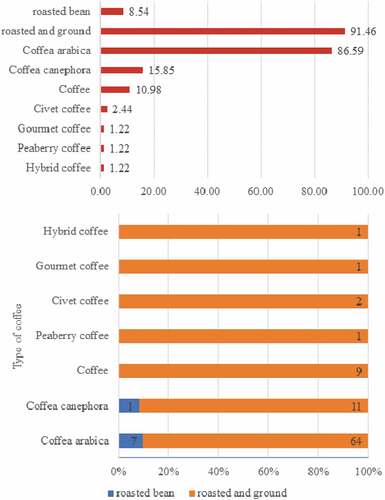
C. arabica and C. canephora were the only species investigated, certainly, because they are mainly species commercialized worldwide. Among the process of roasted coffee, the major type was roasted and ground (), this can be explained by the facility being used as a target of adulteration due to its particle size, texture, and color, which may mask the adulterants (both coffee and other vegetable matrixes).
Note that some categories of coffee should be also be investigated, which represented less than 5% of works (4 studies, ), i.e., Gourmet, Civet, Peaberry, and Hybrid. These types of coffee have a high price and are expected to be of high quality; however, they are not free from adulterations. C. arabica and roasted and ground coffee were shown as the most studied matrices. Furthermore, Civet coffee can be highlighted as the most studied among the best coffees available in the market. Gourmet coffees must be made from 100% Arabica coffee of unique origin or “blended” that meets both the characteristics and the overall quality of the beverage, and it cannot contain beans with black, green, and burnt defects .[Citation82] Civet coffee is a coffee bean (Arabica or Robusta) that has been eaten and passed through the digestive tract of Asian palm civet (Paradoxurus hermaphroditus), which selects only the best and ripest berries, generating a rarity coffee and its production process recently accounts for its high selling price, around a hundred times higher than regular coffee .[Citation68] Peaberry (also called caracol or snail in Spanish) is a natural mutation of the coffee bean inside the cherry, and its higher price occurs from its supposed more concentrated flavor compared with normal beans .[Citation69]
With the purpose to analyze the proportion of roasted beans and roasted ground per type of coffee, another graph was constructed with the same data, . The type of coffee most frequently analyzed was “roasted and ground” in both species and quality of coffee. Roasted bean was only studied in C. canephora and C. arabica species (), probably due to their commercialization not only as ground coffee but also in whole beans. After grinding the discrimination between the coffee and the adulterant (including another type of coffee) cannot be detected visually .[Citation69]
Type of adulterant
A plethora of different coffee adulterants have been investigated during the last twenty years, as shown in and .
Figure 3. Percentage of selected studies by type of coffee adulterant analyzed (2000–2021). The number of studies was inserted at the outer end of the bar.
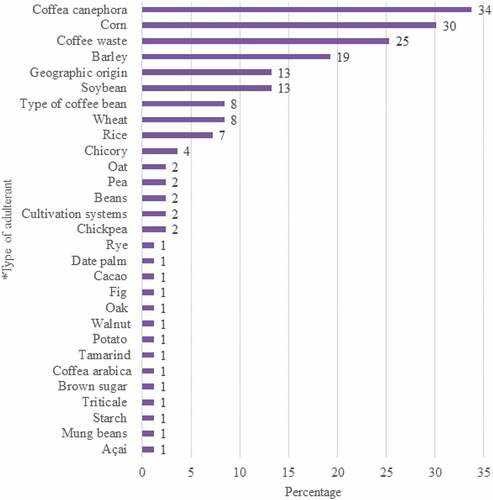
Type of adulterant
Coffee waste: coffee husks, cleaned husks, skin, pulp, sticks, parchment, spent coffee grounds, other residues from the coffee processing, low-grade green coffee, silverskin, mucilage; Type of coffee bean: soft, hard, rio, etc; gourmet, traditional and superior; black, green or sour bean coffee; low quality; Corn: corn, maize, cornmeal; Oat: oat, oatmeal; Cultivation systems: organic; conventional; Geographical origin: coffee regions of production, such as country region, country or continent.
A total of twenty-nine adulterants have been investigated during the last twenty years. As expected, C. canephora and coffee wastes (coffee husks, cleaned husks, skin, pulp, sticks, parchment, spent coffee grounds, other residues from the coffee processing, low-grade green coffee, silverskin, mucilage) are at the top of the list, in the first and third place, respectively. Both adulterants are part of the coffee plant, making it difficult to be detected by common analytical tools due to the similarity of their chemical composition. In this way, they are frequently targeted to be used as a coffee adulterant.
Some adulterants were among the most studied ones, such as C. canephora, corn, coffee waste, and barley, investigated in more than 15% of the studies, perhaps due to their common use in roasted coffee. Corn was second among all coffee adulterants and in first place among the non-coffee vegetable matrices, probably due to its expressive low cost and texture similarities, justifying the huge number of research approaches using this sample.
Following corn, in fourth, sixth, seventh, ninth, and tenth place are barley, soybean, wheat, rice, and chicory, respectively. Like with corn, these adulterants also have low cost and, when added at the same roast level of coffee, are masked by absorption and adherence of the finer particles of the ground and roasted coffee to their surfaces. Therefore, while the roasting process is a critical stage in coffee processing, essential in the determination of coffee quality by the production of the desirable flavor and aroma, it also provides conditions for adulteration .[Citation28,Citation35,Citation95] The use of darker roasting for coffee is also a frequent resource, which makes adulterant detection more difficult due to the production of interferent compounds .[Citation42]
The list is longer due to some fewer common adulterants, representing less than 5% evaluated in the studies. These adulterants are probably used in coffee according to its production region or country and/or accessibility, namely, açai, chickpea, mung beans, starch, triticale, brown sugar, chicory, tamarind, potato, beans, walnut, oak, fig, cacao, pea, oat, date palm, and rye. It is important to highlight that in the selection stage, drugs were reported mostly in instant coffee, however according to the criteria of exclusion (Studies in instant coffee) those studies were excluded in the selection step.
Another interesting piece of data was the number of adulterants evaluated by the studies, as shown in , being clear that in the majority of the selected studies only one adulterant was investigated at a time (n = 50), followed by the investigation of two (n = 14), three (n = 9), and four (n = 5) adulterants per work. Multi-detection approaches, with five,[Citation29] six,[Citation42] seven,[Citation56] and sixteen[Citation19] adulterants were only investigated in one work at a time. This result shows the importance to explore different adulterants, in different concentrations and combinations, mainly considering an unknown sample, which may contain a diversity of adulterants and concentrations and offer a plethora of possibilities to be detected by the techniques. Possible reasons might justify a minor number of studies with a multi-detection approach, described as follows: the investigation of chemical markers of adulteration[Citation86]; the interest in differentiation between the C. arabica and C. canephora species[Citation21,Citation51]; the geographical origin of coffee required by the market and consumer .[Citation47]
Detection techniques
The detection and quantification of adulterants in roasted coffee, mainly roasted and ground coffee, has been a challenge in the field of food safety and quality for the scientific research community worldwide. Hence, a diversity of analytical techniques and methods have been employed (). These tools need to be increasingly effective to meet the urgent demand for more assertive analytical techniques as a tool in the roasted coffee inspection. The results shown in match this trend.
Figure 5. Percentage of selected studies by techniques applied in the detection and/or quantification of coffee adulteration. The number of studies was inserted at the outer end of the bar.
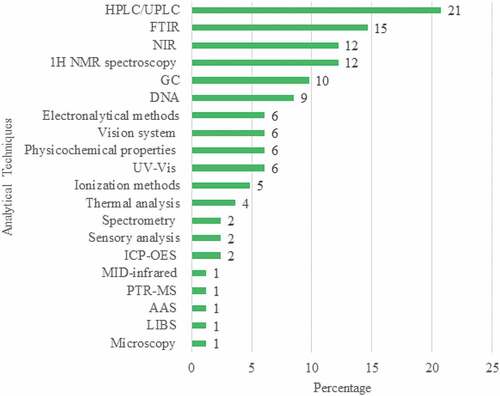
A total of twenty techniques has been explored in the last twenty years to detect and/or quantify the adulteration of roasted bean or ground coffee. Among the most studied techniques were HPLC/UPLC, FTIR, NIR, and 1H NMR, investigated in more than 10% of the works analyzed. Nevertheless, it is important to highlight two techniques that have been explored in the works, namely GC and DNA analysis, representing around 8–9% of the tested techniques in the studies.
Regarding the methods, liquid and gas chromatography (HPLC/UPLC, GC) and spectroscopy (FTIR, NIR, 1H NMR) are among the top five techniques applied in the detection/quantification of coffee adulteration. Chromatographic techniques, associated with different detection systems, allow both the identification of chemical adulteration markers and a fingerprinting approach in food authentication, such as for coffee .[Citation19,Citation24] However, the major disadvantage of this technique is the use of chemical reagents that destroy the sample and pollute the environment.
On the other hand, spectroscopy is also among the most employed techniques in coffee authenticity. The application of spectroscopic analysis, mainly NIR and FTIR, for authentication of food samples is only viable when associated with chemometric approaches, such as Principal Component Analysis (PCA) and Partial Least Squares Discriminant Analysis (PLS-DA), and with complex samples such as coffee is no different .[Citation30,Citation36,Citation37,Citation88] It has been widely used as an alternative analytical method, without requiring solvents or reagents, representing a nondestructive analysis and a green analytical tool .[Citation73,Citation91] Thus, this technique presents a potential alternative to be used by inspection bodies, also because it is sensitive, rapid, and requires very little sample preparation.
Nevertheless, some techniques represented at least between 6–9% as the most studied (), namely DNA, electroanalytical methods, UV-Vis spectroscopy, physicochemical properties, and vision system. Among them, DNA analysis stands out as an important tool, in the sixth place of the most applied techniques. The DNA-based methods allow identifying the type of plant and species used in the adulteration, as well as their relative quantification. Nonetheless, DNA extraction can present an important drawback, mainly in highly processed, cooked, or roasted food, such as in the case of coffee, because the co-extraction of enzymatic inhibitors might prevent the suitable detection and consequently the quantification. Thus, DNA techniques have been mainly explored in the improvement of extraction methods from roasted coffee and coffee adulterants .[Citation55,Citation57,Citation59,Citation60]
The remaining techniques represented less than 5% in the detection/quantification of coffee adulteration. Most of them have been recently employed as a new approach in this field, considering techniques employed according to the years, as shown in the following .
In the early 2000s, scientific works only explored 1 or 2 types of techniques, such as spectrometry, GC, and microscopy (). Over the years, the number of techniques used by research groups has grown up, particularly since 2012, with at least seven different techniques per year since 2016, and with eleven different techniques tested in 2021, an expressive increase of approaches explored worldwide.
Despite the prevalence of chromatographic and spectroscopy reports in this field, other techniques must be highlighted as a trend in the last five years, namely thermal analysis, Atomic Absorption Spectroscopy (AAS), Laser-Induced Breakdown Spectroscopy (LIBS), sensory analysis, and electroanalytical analysis. Most of these last analyzes were applied in one work. Among them, electroanalytical analysis stands out due to possible options of methods, mainly electronic tongue, and electronic nose, being an interesting alternative to sensory analysis.
Another important data-crossing approach used for the collection of data of this systematic review was to correlate the proportion of techniques and the adulterants investigated according to .
Figure 7. The proportion of studies by type of adulterants investigated using analytical techniques. The number of studies was inserted in the middle of the bar, corresponding to the analytical technique used for each adulterant.
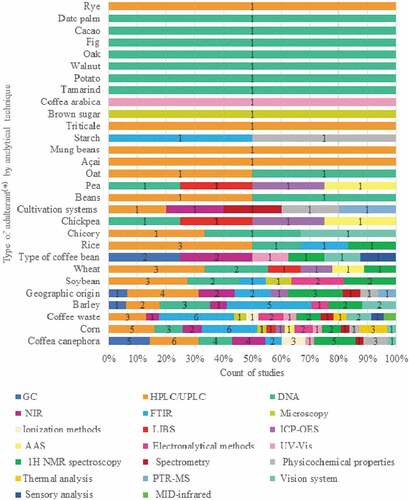
Type of adulterant
Coffee waste: coffee husks, cleaned husks, skin, pulp, sticks, parchment, spent coffee grounds, other residues from the coffee processing, low-grade green coffee, silverskin, mucilage; Type of coffee bean: soft, hard, rio, etc; gourmet, traditional and superior; black, green or sour bean coffee; low quality; Corn: corn, maize, cornmeal; Oat: oat, oatmeal; Cultivation systems: organic; conventional; Geographical origin: coffee regions of production, such as country region, country or continent.
In , it was observed that some adulterants were evaluated by at least 6 different techniques in the last twenty years, with corn being the winning adulterant, evaluated by 15 techniques. Under the discussion in the type of adulterant section, the most studied adulterants were also those with more quantity of techniques employed (C. canephora, corn, coffee waste, barley, geographic origin, soybean, wheat, type of coffee bean, and rice). In contrast, the less common adulterants (chickpea, mung beans, cultivation systems, starch, triticale, brown sugar, C. arabica, chicory, tamarind, potato, beans, walnut, oak, fig, cacao, pea, oat, date palm, rye) of roasted bean or ground coffee were evaluated with a maximum four techniques.
Among the most studied adulterants, a particular note is given to adulteration involving only coffee, particularly those concerning its geographic origin and type of coffee bean (Arabica/Robusta), the latter already discussed in the type of coffee section. Regarding geographic origin, the interest in coffees from specific origins increased in international markets, along with the consumers that are willing to pay a higher price for specific quality attributes, which are related to the certification given by the particular coffee properties to the producing region .[Citation84,Citation88] Among the selected studies about geographical identification, high-performance liquid chromatography (HPLC) has been the most used technique (n = 4), and it has been shown to distinguish producing region from Brazil,[Citation84] the country of production,[Citation2,Citation17,Citation18] and continent region .[Citation17] In the second place, nuclear magnetic resonance spectroscopy (n = 3) has been shown to differentiate between Arabica coffee grown in Colombia and other countries[Citation46,Citation88] and also among Arabica coffee produced in different continents, namely, America, Africa, and Asia .[Citation47] Therefore, the investigation of coffee adulteration according to geographic origins is essential to provide reliable information on labeling and the fair price for the consumer.
Detection range
The percentage of adulteration detected in the studies was grouped by detection ranges (>0-0.5, >0.5–1.0, >1.0–5.0, >5.0–10.0, >10 .0–20.0, >20.0–30.0, >30.0) (). The detection range most frequently achieved in the reported studies was >10.0–20.0% (n = 35). However, only three works analyzed (less than 10%) in this systematic review had a detection range between >0-0.5%, and twelve studies (less than 15%) were in the >0.5–1.0% range.
Figure 8. Number of studies according to adulterant detection range of selected studies of adulteration in roasted coffee.
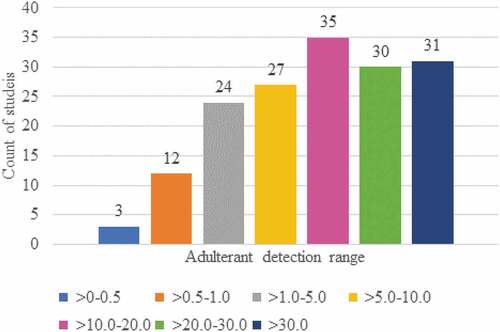
In addition to this data, the adulterants most studied in lower amounts were: chicory (n = 1), barley (n = 2), Coffea canephora (n = 2), considering >0-0.5% range; and rice (n = 2), barley (n = 6), corn (n = 6), wheat (n = 1), coffee waste (n = 4), Coffea canephora (n = 2), type of coffee bean (n = 1), chicory (n = 1). On the other hand, the adulterants most explored in higher quantities, i.e. >30.0% range, were: barley (n = 8), corn (n = 16), soybean (n = 7), rice (n = 4), wheat (n = 5), coffee waste (n = 11), Coffea canephora (n = 9), chickpea (n = 1), geographic origin (n = 4), type of coffee bean (n = 1), brown sugar (n = 1), chicory (n = 1), pea (n = 1), oat (n = 1), rye (n = 1). This data is important concerning the coffee identity and quality standards.
In Brazil, for instance, the legislation on coffee identity and quality standards allowed only up to 1% of impurities, sediment, and foreign matter in Roasted Coffee Beans and Roasted and Ground Coffee through Normative Instruction n°16 .[Citation99] However, since 2013, this norm was revoked by Normative Instruction n°7,[Citation100] leaving this limit inaccurate. Nowadays, after careful discussion a new regulation for the roasted coffee was established to ensure quality control and safety for the consumption of this product. To this end, a new Official Coffee Classification Standard from the Ministry of Agriculture, Livestock and Food Supply[Citation101] was allows a limit of up to 1% of foreign matter and impurities in coffee, which is essential to establish its quality, safety, and inspection. Scientific studies need to focus on the detection and quantification of small percentages of adulterants (>0-5%) accordingly to the requirement of the legislation.
Thus, another data crossing was performed, considering the detection range and the detection techniques (). Despite the limit of detection being reported from 0.31 to 0.86% by the NMR technique,[Citation42] the smallest detection range was shown by the GC, NIR, and vision system techniques, up to 0–0.5% (). Nevertheless, one cannot fail to highlight the ranges >0.5–1.0 and >1.0–5.0, which had a diversity of techniques able to detect and quantify the adulterants, such as GC, HPLC/UPLC, FTIR, MID-infrared, Thermal analysis, sensory analysis, among others.
Figure 9. The proportion of studies according to the detection range quantified by the analytical technique. The number of studies was inserted in the middle of the bar, corresponding to the analytical technique used for each detection range.
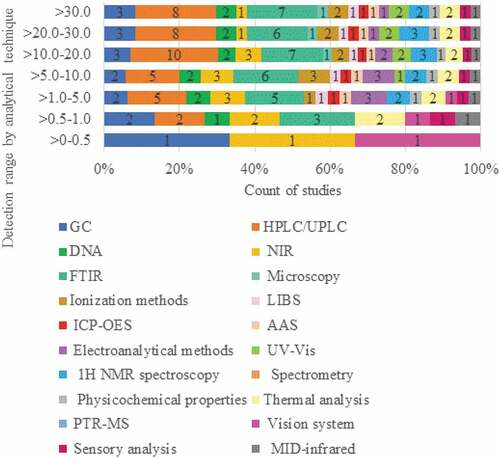
Regarding the microscopy technique, known in Brazil to be adopted as the official method of microscopy and visual analysis for the assessment of macro and microscopic extraneous in coffee,[Citation102] it was able to quantify adulteration only above 10% in roasted coffee. This result shows again the limitation of the determination of a percentage of impurities in coffee by microscopy according to legislation about the coffee identity and quality standards .[Citation99–101]
The selected studies showed a diversity of investigated adulteration percentages, also in smaller percentages (>0.5–1.0 and >1.0–5.0). Despite the diversity of adulterant detection range and techniques applied in the studies, other variables need to be further explored in the samples to corroborate these results, considering the variety of adulterants and types of coffee, as well as their conditions, such as the degree of roasting. Moreover, in the case of Brazil, with limited legislation regarding the determination of the percentage of coffee adulteration,[Citation101] it is urgent the adoption of one or more techniques capable of detecting and/or quantifying coffee adulteration in low percentages. For the qualitative approach, the techniques used to discriminate the samples were considered, as well as their analysis of chemical and/or nutritional composition ().
The techniques most employed in the qualitative analysis of coffee adulteration were HPLC/UPLC, FTIR, and NIR. These data show that even in qualitative analyzes there is a tendency to use chromatographic and spectroscopic analysis in the investigation of coffee adulteration.
Limitations of the studies
Roasted coffee (bean or ground) is a complex matrix due to its chemical composition, environmental influence, and processing steps mainly the transformation of them during the roasting process. In addition, a diversity of adulterants can be used in roasted coffee, predominantly in roasted and ground coffee in different percentages and types of adulterants at the same time.
Some variables should be well defined and described in the methodology, such as the number of samples (n), the roasting degree, the species of coffee, the process of coffee (bean or ground), and the type of adulterant. One of the main points of the methodology is to guarantee the scientific rigor and reliability of the results and the reproducibility of the study. Thus, it is essential when it comes to research into roasted coffee, the detailed and objective delimitation of the sample number, which sometimes was not mentioned directly (n = X) by the study authors and had to be calculated by the reviewers.
Concerning the roasting degree of both coffee and adulterants, it is an extremely important variable regarding the detection and quantification of adulteration, as it is known that many adulterated coffees use this feature to “coverup” the adulterants, through a more intense roasting. A more intense roasting produces degradation compounds, which act as interferents in different analyses, in addition to carbonizing some compounds, which also prevents their detection/quantification. Some articles do not describe the degree of roasting. One of the reasons is that coffee companies donate samples and therefore this information is unknown. However, some techniques are well-known and consensual for evaluating the color associated with the roasting degree, such as the Agtrom scale and the CIELAB color space. In the absence of this parameter, it is always suggested to indicate the temperature, time and roaster used both for the coffee and for the different adulterants.
Another aspect is about sampling, the option “Coffee” had to be added to the type of coffee field, as some studies did not identify which type of coffee was. This can be justified when dealing with commercial samples in which it was not indicated on the label which species they belonged to. However, when the species is known, its description is essential, due to the different chemical compositions between them, and may present different results. Also, concerning sampling, it is suggested, whenever possible, to use mainly different varieties and origins (country and regions) to increase the variability of samples both of coffee and adulterants, making the sampling more representative.
Conclusion
For the first time in the literature, a systematic review was reported on techniques for detecting adulteration in roasted and ground coffee applied in the last 20 years. The systematization of these data allowed not only to give some examples of techniques used or focused on a specific type of adulteration in roasted coffee, but also to offer concrete data and trends in the investigation profile, both related to analytical techniques, and also concerning the types of coffee subject to adulteration, types of adulterants, percentages of adulteration most studied, carried out by different research groups around the world. StArt proved an efficient and essential tool in all stages of the development of the systematic review, with the standardization of data and, consequently, providing greater scientific rigor. The type of coffee most studied according to the species was C. arabica, highlighting coffees with a high price in the market, which has been also investigated as a target of adulteration such as Gourmet, Civet, and Peaberry coffee, and the type of process was roasted and ground, probably due to its particle size, texture, and color, which may easily mask adulterants. Among the most studied adulterants of roasted coffee, C. canephora and coffee waste were in first and third place, respectively. The similarity of chemical composition, due to both being part of coffee, turns the detection difficult and the need for sensitive techniques primordial. Including other vegetal matrices, corn was the most studied matrix, in second place, and the most evaluated by different analytical techniques (n = 15). This matrix, as well as barley, soybean, wheat, rice, and chicory, are widely used to adulterate coffee mainly due to its lower cost and its similarity with roasted and ground coffee after roasting and ground. A tendency for the application of chromatographic and spectroscopy analysis was observed, through most techniques studied for the detection of coffee adulteration, namely HPLC/UPLC in the first place, followed by FTIR, NIR, 1H NMR, which were able to detect adulterants in lower percentages (≤ 1.0%). In addition, in the case of spectroscopy, there is the advantage of being a green approach, as it does not use reagents in the analysis, nor compromise the sample and the environment. Thus, these data showed the urgency of the adopting of one or more reliable techniques, which are capable of detecting and quantifying the level of adulteration below 1% in roasted and ground coffee, at least in accordance with the limit proposed by the Brazilian legislation. In addition, coffee and its adulterants are complex samples due to high processing, which requires techniques with greater accuracy. For this, it is also necessary the focus on the detection and quantification of small percentages (>0-5%) of adulterants by scientific studies. In addition, the majority of the studies investigated only one adulterant at a time, showing the need adulterant multi-detection approach, considering the different types of adulterants and possible concentrations in coffee. This systematic review is an important contribution to the investigation of coffee adulteration. Moreover, it is crucial the advancement the investigation for suitable technique (s) to detect the adulteration in coffee, mainly considering the most common adulterants, different percentages, and combinations of them in coffee.
Supplemental Material
Download ()Acknowledgments
This study was financed in part by the Coordenação de Aperfeiçoamento de Pessoal de Nível Superior—Brasil (CAPES)—Finance Code 001, and by FCT/MCTES through national funds and, where applicable, co-financed by the FEDER, within the PT2020 Partnership Agreement and Compete 2020 under project UIDB/50006/2020 and UIDP/50006/2020, for which the authors are grateful.
Disclosure statement
No potential conflict of interest was reported by the author(s).
Supplementary material
Supplemental data for this article can be accessed online at https://doi.org/10.1080/10942912.2022.2158865
Additional information
Funding
References
- ICO. International Coffee Organization. Coffee Production by Exporting Countries (London), 2022.
- Núñez, N.; Martínez, C.; Saurina, J.; Núñez, O., et al. High-performance Liquid Chromatography with Fluorescence Detection Fingerprints as Chemical Descriptors to Authenticate the Origin, Variety and Roasting Degree of Coffee by Multivariate Chemometric Methods. J. Sci. Food Agric. 2021, 101(1), 65–73.
- Abrahão, S. A.; Pereira, R. G. F. A.; Duarte, S. M. D. S.; Lima, A. R.; Alvarenga, D. J.; Ferreira, E. B., et al. COMPOSTOS BIOATIVOS E ATIVIDADE ANTIOXIDANTE DO CAFÉ. Ciênc agrotec. 2010, 34(2), 414–420. DOI: 10.1590/S1413-70542010000200020
- Assad, E. D.; Sano, E. E.; Cunha, S. A. R. D.; Rodrigues, H. R.; Corrêa, T. B S. 2000. Brasília: Embrapa Café, 699–701.
- Oliveira, G. Efeito de Diferentes Pontos de Torração E Tipos de Granulometria Na Concentração de Ocratoxina “A” Em Grãos de Café. 2012. Minas Gerais: Universidade Federal de Lavras.
- Miranda, S. F. USO DE IMAGENS NA IDENTIFICAÇÃO DE IMPUREZAS EM PÓ DE CAFÉ. 2014. Brasília: Universidade de Brasília.
- Pauli, E. D.; Barbieri, F.; Garcia, P. S.; Madeira, T. B.; Acquaro, V. R.; Scarminio, I. S.; da Camara, C. A. P.; Nixdorf, S. L., et al. Detection of Ground Roasted Coffee Adulteration with Roasted Soybean and Wheat. Food Res. Int. 2014, 61, 112–119. DOI: 10.1016/j.foodres.2014.02.032.
- Reis, N.; Franca, A. S.; Oliveira, L. S. Performance of Diffuse Reflectance Infrared Fourier Transform Spectroscopy and Chemometrics for Detection of Multiple Adulterants in Roasted and Ground Coffee. LWT - Food Sci. Technol. 2013, 53(2), 395–401. DOI: 10.1016/j.lwt.2013.04.008.
- AOAC. Official Methods Filth in Ground Coffees and Coffee Substitutes Sub Chapter 2. AOAC. Beverages and Beverage Materials, AOAC: Gaithersburg, 1995; pp98.
- MS. Ministério da Saúde. Agência Nacional de Vigilância Sanitária – ANVISA. Resolução da Diretoria Colegiada – RDC 623, de 16 de março de 2022. 2022.
- Lopez, F. C. Determinação do sedimento, cascas e paus no café torrado e moído. Revista Instituto Adolfo Lutz. 1974, 34, 29–34.
- Mendes, L. C.; Santos, J. C. F.; Corrêa, J. A.; Alkimim, J. F. D.; Silva, D. V. R. D.; Jesus, L. N. D.; Dibai, W. L. S. Validação de método para determinação das impurezas cascas e paus em café torrado e moído. Braz. J. Food Technol. 2016, 19.
- Cheng, F.; Wu, J.; Zhang, J.; Pan, A.; Quan, S.; Zhang, D.; Kim, H.; Li, X.; Zhou, S.; Yang, L., et al. Development and inter-laboratory Transfer of a Decaplex Polymerase Chain Reaction Assay Combined with Capillary Electrophoresis for the Simultaneous Detection of ten Food Allergens. Food Chem. 2016, 199, 799–808. DOI: 10.1016/j.foodchem.2015.12.058.
- Toci, A. T.; Farah, A.; Pezza, H. R.; Pezza, L., et al. Coffee Adulteration: More than Two Decades of Research. Crit. Rev. Anal. Chem. 2016, 46(2), 83–92.
- Burns, D. T.; Tweed, L.; Walker, M. J. Ground Roast Coffee: Review of Analytical Strategies to Estimate Geographic Origin, Species Authenticity and Adulteration by Dilution. Food Anal. Methods. 2017, 10(7), 2302–2310. DOI: 10.1007/s12161-016-0756-3.
- Wang, X.; Lim, L. T.; Fu, Y. Review of Analytical Methods to Detect Adulteration in Coffee. J. AOAC Int. 2020, 103(2), 295–305. DOI: 10.1093/jaocint/qsz019.
- Núñez, N.; Collado, X.; Martínez, C.; Saurina, J.; Núñez, O., et al. Authentication of the Origin, Variety and Roasting Degree of Coffee Samples by Non-Targeted HPLC-UV Fingerprinting and Chemometrics. Application to the Detection and Quantitation of Adulterated Coffee Samples. Foods 2020, 9(3). doi:10.3390/foods9030378
- Núñez, N.; Saurina, J.; Núñez, O. Non-targeted HPLC-FLD Fingerprinting for the Detection and Quantitation of Adulterated Coffee Samples by Chemometrics. Food Control. 2021, 124, 107912. DOI: 10.1016/j.foodcont.2021.107912.
- Núñez, N.; Saurina, J.; Núñez, O. Authenticity Assessment and Fraud Quantitation of Coffee Adulterated with Chicory, Barley, and Flours by Untargeted HPLC-UV-FLD Fingerprinting and Chemometrics. Foods. 2021, 10(4), 840. DOI: 10.3390/foods10040840.
- Cheah, W. L.; Fang, M. HPLC-Based Chemometric Analysis for Coffee Adulteration. Foods. 2020, 9(7), 880. DOI: 10.3390/foods9070880.
- Zanin, R. C.; Kitzberger, C. S. G.; Benassi, M. D. T. Characterization of Roasted Coffea Arabica Species by the Relationship between Caffeine and Diterpenes Contents. Braz. Arch. Biol. Technol. 63, 2020, 1–8.
- Song, H. Y.; Jang, H. W.; Debnath, T.; Lee, K.-G., et al. Analytical Method to Detect Adulteration of Ground Roasted Coffee. Int. J. Food Sci. Technol. 2019, 54(1), 256–262.
- Cai, T.; Ting, H.; Jin-Lan, Z. Novel Identification Strategy for Ground Coffee Adulteration Based on UPLC-HRMS Oligosaccharide Profiling. Food Chem. 2016, 190, 1046–1049. DOI: 10.1016/j.foodchem.2015.06.084.
- Tavares, K. M.; Lima, A. R.; Nunes, C. A.; Silva, V. A.; Mendes, E.; Casal, S.; Pereira, R. G. F. A., et al. Free Tocopherols as Chemical Markers for Arabica Coffee Adulteration with Maize and Coffee by-products. Food Control. 2016, 70, 318–324. DOI: 10.1016/j.foodcont.2016.06.011.
- Domingues, D. S.; Pauli, E. D.; de Abreu, J. E. M.; Massura, F. W.; Cristiano, V.; Santos, M. J.; Nixdorf, S. L., et al. Detection of Roasted and Ground Coffee Adulteration by HPLC and by Amperometric and by post-column Derivatization UV-Vis Detection. Food Chem. 2014, 146, 353–362. DOI: 10.1016/j.foodchem.2013.09.066.
- Campanha, F. G.; Dias, R. C. E.; Benassi, M. D. T. Discrimination of Coffee Species Using Kahweol and Cafestol: Effescts of Roasting and of Defects. Coffee Sci 2010, 5(1), 87–96.
- Garcia, L. M. Z.; Pauli, E. D.; Cristiano, V.; da Camara, C. A. P.; Scarminio, I. S.; Nixdorf, S. L., et al. Chemometric Evaluation of Adulteration Profile in Coffee Due to Corn and Husk by Determining Carbohydrates Using HPAEC-PAD. J. Chromatogr. Sci. 2009, 47(9), 825–832.
- Jham, G. N.; Winkler, J. K.; Berhow, M. A.; Vaughn, S. F., et al. γ-Tocopherol as a Marker of Brazilian Coffee (Coffea Arabica L.) Adulteration by Corn. J Agri Food Chem. 2007, 55(15), 5995–5999. DOI: 10.1021/jf070967n
- Flores-Valdez, M.; Meza-Márquez, O. G.; Osorio-Revilla, G.; Gallardo-Velázquez, T., et al. Identification and Quantification of Adulterants in Coffee (Coffea Arabica L.) Using FT-MIR Spectroscopy Coupled with Chemometrics. Foods. 2020, 9(7), 851.
- Reis, N.; Botelho, B. G.; Franca, A. S.; Oliveira, L. S., et al. Simultaneous Detection of Multiple Adulterants in Ground Roasted Coffee by ATR-FTIR Spectroscopy and Data Fusion. Food Anal. Methods. 2017, 10(8), 2700–2709.
- Reis, N.; Franca, A. S.; Oliveira, L. S. Concomitant Use of Fourier Transform Infrared Attenuated Total Reflectance Spectroscopy and Chemometrics for Quantification of Multiple Adulterants in Roasted and Ground Coffee. J. Spectrosc. 2016, 2016, 1–7. DOI: 10.1155/2016/4974173.
- Reis, N.; Franca, A. S.; Oliveira, L. S. Quantitative Evaluation of Multiple Adulterants in Roasted Coffee by Diffuse Reflectance Infrared Fourier Transform Spectroscopy (DRIFTS) and Chemometrics. Talanta. 2013, 115, 563–568. DOI: 10.1016/j.talanta.2013.06.004.
- Craig, A. P.; Franca, A. S.; Oliveira, L. S. Discrimination between Defective and non-defective Roasted Coffees by Diffuse Reflectance Infrared Fourier Transform Spectroscopy. Lwt. 2012, 47(2), 505–511. DOI: 10.1016/j.lwt.2012.02.016.
- Wang, J.; Jun, S.; Bittenbender, H. C.; Gautz, L.; Li, Q. X., et al. Fourier Transform Infrared Spectroscopy for Kona Coffee Authentication. J. Food Sci. 2009, 74(5), C385–91.
- Correia, R. M.; Tosato, F.; Domingos, E.; Rodrigues, R. R. T.; Aquino, L. F. M.; Filgueiras, P. R.; Lacerda, V.; Romão, W., et al. Portable near Infrared Spectroscopy Applied to Quality Control of Brazilian Coffee. Talanta. 2018, 176, 59–68. DOI: 10.1016/j.talanta.2017.08.009.
- Bertone, E.; Venturello, A.; Giraudo, A.; Pellegrino, G.; Geobaldo, F. J. F. C. Simultaneous Determination by NIR Spectroscopy of the Roasting Degree and Arabica/Robusta Ratio in Roasted and Ground Coffee. Food Control. 2016, 59, 683–689. DOI: 10.1016/j.foodcont.2015.06.055.
- Ebrahimi-Najafabadi, H.; Leardi, R.; Oliveri, P.; Chiara Casolino, M.; Jalali-Heravi, M.; Lanteri, S., et al. Detection of Addition of Barley to Coffee Using near Infrared Spectroscopy and Chemometric Techniques. Talanta. 2012, 99, 175–179. DOI: 10.1016/j.talanta.2012.05.036.
- Santos, K. M.; Moura, M. F. V.; Azevedo, F. G.; Lima, K. M. G.; Raimundo, I. M.; Pasquini, C., et al. Classification of Brazilian Coffee Using Near-Infrared Spectroscopy and Multivariate Calibration. Anal. Lett. 2012, 45(7), 774–781.
- Pizarro, C.; Esteban-Diez, I.; Gonzalez-Saiz, J. M. Mixture Resolution according to the Percentage of Robusta Variety in order to Detect Adulteration in Roasted Coffee by near Infrared Spectroscopy. Anal. Chim. Acta. 2007, 585(2), 266–276. DOI: 10.1016/j.aca.2006.12.057.
- Alves, R. P.; Filho, N. R. A.; Lião, L. M.; Flores, I. S., et al. Evaluation of the Metabolic Profile of Arabica Coffee via NMR in Relation to the Time and Temperature of the Roasting Procedure. J. Braz. Chem. Soc. 2021, 32(1), 123–136.
- Burton, I. W.; Farina, C. F. M.; Ragupathy, S.; Arunachalam, T.; Newmaster, S.; Berrué, F., et al. Quantitative NMR Methodology for the Authentication of Roasted Coffee and Prediction of Blends. J. Agric. Food Chem. 2020, 68(49), 14643–14651.
- Milani, M. I.; Rossini, E. L.; Catelani, T. A.; Pezza, L.; Toci, A. T; Pezza, H. R., et al. Authentication of Roasted and Ground Coffee Samples Containing Multiple Adulterants Using NMR and a Chemometric Approach. Food Control. 112. 2020, 1–7.
- Okaru, A. O.; Scharinger, A.; Rajcic de Rezende, T.; Teipel, J.; Kuballa, T.; Walch, S. G.; Lachenmeier, D. W., et al. Validation of a Quantitative Proton Nuclear Magnetic Resonance Spectroscopic Screening Method for Coffee Quality and Authenticity (NMR Coffee Screener). Foods. 2020, 9(1), 47.
- Ribeiro, M. V. D. M.; Boralle, N.; Pezza, H. R.; Pezza, L.; Toci, A. T., et al. Authenticity of Roasted Coffee Using 1 H NMR Spectroscopy. J. Food Compost. Anal. 2017, 57, 24–30. DOI: 10.1016/j.jfca.2016.12.004.
- Defernez, M.; Wren, E.; Watson, A. D.; Gunning, Y.; Colquhoun, I. J.; Le Gall, G.; Williamson, D.; Kemsley, E. K., et al. Low-field (1)H NMR Spectroscopy for Distinguishing between Arabica and Robusta Ground Roast Coffees. Food Chem. 2017, 216, 106–113. DOI: 10.1016/j.foodchem.2016.08.028.
- Arana, V. A.; Medina, J.; Alarcon, R.; Moreno, E.,;Heintz, L.Schäfer, H. ;Wist, J., et al. Coffee’s Country of Origin Determined by NMR: The Colombian Case. Food Chem. 2015, 175, 500–506. DOI: 10.1016/j.foodchem.2014.11.160.
- Consonni, R.; Cagliani, L. R.; Cogliati, C. NMR Based Geographical Characterization of Roasted Coffee. Talanta. 2012, 88, 420–426.
- Hung, Y.-C.; Lee, F.-S.; Lin, C.-I. Classification of Coffee Bean Categories Based upon Analysis of Fatty Acid Ingredients. J. Food Process. Preserv. 2021, 45(9). DOI: 10.1111/jfpp.15703.
- Konieczka, P. P.; Aliño-González, M. J.; Ferreiro-González, M.; Barbero, G. F.; Palma, M., et al. Characterization of Arabica and Robusta Coffees by Ion Mobility Sum Spectrum. Sensors.2020, 20(11), 1–15.
- Jumhawan, U.; Putri, S. P.; Bamba, T.; Fukusaki, E., et al. Quantification of Coffee Blends for Authentication of Asian Palm Civet Coffee (Kopi Luwak) via Metabolomics: A Proof of Concept. J. Biosci. Bioeng. 2016, 122(1), 79–84.
- Toledo, B. R.; Hantao, L. W.; Ho, T. D.; Augusto, F.; Anderson, J. L., et al. A Chemometric Approach toward the Detection and Quantification of Coffee Adulteration by solid-phase Microextraction Using Polymeric Ionic Liquid Sorbent Coatings. J. Chromatogr. A. 2014, 1346, 1–7. DOI: 10.1016/j.chroma.2014.04.035.
- Romano, R.; Santini, A.; Le Grottaglie, L.; Manzo, N.; Visconti, A.; Ritieni, A., et al. Identification Markers Based on Fatty Acid Composition to Differentiate between Roasted Arabica and Canephora (Robusta) Coffee Varieties in Mixtures. J. Food Compost. Anal. 2014, 35(1), 1–9.
- Oliveira, R. C. S.; Oliveira, L. S.; Franca, A. S.; Augusti, R., et al. Evaluation of the Potential of SPME-GC-MS and Chemometrics to Detect Adulteration of Ground Roasted Coffee with Roasted Barley. J. Food Compost. Anal. 2009, 22(3), 257–261.
- Mondello, L.; Casilli, A.; Tranchida, P. Q.; Dugo, P.; Costa, R.; Festa, S.; Dugo, G., et al. Comprehensive Multidimensional GC for the Characterization of Roasted Coffee Beans. J. Sep. Sci. 2004, 27(5–6), 442–450.
- Bosmali, I.; Lagiotis, G.; Stavridou, E.; Haider, N.; Osathanunkul, M.; Pasentsis, K.; Madesis, P., et al. Novel Authentication Approach for Coffee Beans and the Brewed Beverage Using a nuclear-based species-specific Marker Coupled with High Resolution Melting Analysis. Lwt, 137. 2021, 1–8.
- Haider, N.; Nabulsi, I. Identification of Coffee and a Set of Its Potential PlantDerived Adulterants Using ccSSR-PCR Markers. Inn Sci Info Services Net 2021, 18(1), 312–327.
- Combes, M.-C.; Joët, T.; Lashermes, P. Development of a Rapid and Efficient DNA-based Method to Detect and Quantify Adulterations in Coffee (Arabica versus Robusta). Food Control. 2018, 88, 198–206.
- Uncu, A. T.; Uncu, A. O. Plastid trnH-psbA Intergenic Spacer Serves as a PCR-based Marker to Detect Common Grain Adulterants of Coffee (Coffea Arabica L.). Food Control. 2018, 91, 32–39. DOI: 10.1016/j.foodcont.2018.03.029.
- Ferreira, T.; Farah, A.; Oliveira, T. C.; Lima, I. S.; Vitório, F.; Oliveira, E. M. M., et al. Using Real-Time PCR as a Tool for Monitoring the Authenticity of Commercial Coffees. Food Chem. 2016, 199, 433–438. DOI: 10.1016/j.foodchem.2015.12.045.
- Spaniolas, S.; Tsachaki, M.; Bennett, M. J.; Tucker, G. A., et al. Evaluation of DNA Extraction Methods from Green and Roasted Coffee Beans. Food Control. 2008, 19(3), 257–262.
- Spaniolas, S.; May, S. T.; Bennett, M. J.; Tucker, G. A., et al. Authentication of Coffee by Means of PCR-RFLP Analysis and lab-on-a-chip Capillary Electrophoresis. J. Agric. Food Chem. 2006, 54(20), 7466–7470.
- Rodrigues, D. R.; Fragoso, W. D.; Lemos, S. G. Electronic Tongue Based on a Single Impedimetric Sensor and Complex numbers-supervised Pattern Recognition. Electrochim. Acta. 2021, 397, 139312. DOI: 10.1016/j.electacta.2021.139312.
- Morais, T. C. B.; Rodrigues, D. R.; Souto, U. T. C. P.; Lemos, S. G., et al. A Simple Voltammetric Electronic Tongue for the Analysis of Coffee Adulterations. Food Chem. 2019, 273, 31–38. DOI: 10.1016/j.foodchem.2018.04.136.
- Arrieta, A. A.; Arrieta, P. L.; Mendoza, J. M. Analysis of Coffee Adulterated with Roasted Corn and Roasted Soybean Using Voltammetric Electronic Tongue. Acta Scientiarum Polonorum Technologia Alimentaria. 2019, 18(1), 35–41.
- Daniel, D.; Lopes, F. S.; Santos, V. B. D.; Do Lago, C. L., et al. Detection of Coffee Adulteration with Soybean and Corn by Capillary electrophoresis-tandem Mass Spectrometry. Food Chem. 2018, 243, 305–310. DOI: 10.1016/j.foodchem.2017.09.140.
- Yulia, M.; Suhandy, D. Quantification of Corn Adulteration in Wet and Dry-Processed Peaberry Ground Roasted Coffees by UV-Vis Spectroscopy and Chemometrics. Molecules. 2021, 26(20), 6091. DOI: 10.3390/molecules26206091.
- Dankowska, A.; Domagala, A.; Kowalewski, W. Quantification of Coffea Arabica and Coffea Canephora Var. Robusta Concentration in Blends by Means of Synchronous Fluorescence and UV-Vis Spectroscopies. Talanta. 2017, 172, 215–220. DOI: 10.1016/j.talanta.2017.05.036.
- Suhandy, D.; Yulia, M. The Use of Partial Least Square Regression and Spectral Data in UV-Visible Region for Quantification of Adulteration in Indonesian Palm Civet Coffee. Int. J. Food Sci. 2017, 2017, 6274178. DOI: 10.1155/2017/6274178.
- Suhandy, D.; Yulia, M. Peaberry Coffee Discrimination Using UV-visible Spectroscopy Combined with SIMCA and PLS-DA. Int. J. Food Prop. 2017, 20(sup1), S331–S339. DOI: 10.1080/10942912.2017.1296861.
- Souto, U. T. D. C. P.; Barbosa, M. F.; Dantas, H. V.; de Pontes, A. S.; Lyra, W. D. S.; Diniz, P. H. G. D.; de Araújo, M. C. U.; da Silva, E. C., et al. Identification of Adulteration in Ground Roasted Coffees Using UV–Vis Spectroscopy and SPA-LDA. LWT - Food Sci. Technol. 2015, 63(2), 1037–1041.
- Agnoletti, Z.; da S. Oliveira, E. C.; F. Pinheiro, P.; H. Saraiva, S., et al. Discrimination of Arabica and Conilon Coffee from Physicochemical Properties Allied to Chemometrics. Revista Virtual de Química. 2019, 11(3), 785–805.
- Pradana-López, S.; Pérez-Calabuig, A. M.; Cancilla, J. C.; Lozano, M. Á.; Rodrigo, C.; Mena, M. L.; Torrecilla, J. S., et al. Deep Transfer Learning to Verify Quality and Safety of Ground Coffee. Food Control. 2021, 122, 107801. DOI: 10.1016/j.foodcont.2020.107801.
- Souto, U. T. D. C. P.; Barbosa, M. F.; Dantas, H. V.; de Pontes, A. S.; Lyra, W. D. S.; Diniz, P. H. G. D.; de Araújo, M. C. U.; da Silva, E. C., et al. Screening for Coffee Adulteration Using Digital Images and SPA-LDA. Food Anal. Methods. 2014, 8(6), 1515–1521.
- Gerbig, S.; Neese, S.; Penner, A.; Spengler, B.; Schulz, S., et al. Real-Time Food Authentication Using a Miniature Mass Spectrometer. Anal. Chem. 2017, 89(20), 10717–10725.
- Aquino, F. J. T.; Augusti, R.; Alves, J. D. O.; Diniz, M. E. R.; Morais, S. A. L.; Alves, B. H. P.; Nascimento, E. A.; Sabino, A. A., et al. Direct Infusion Electrospray Ionization Mass Spectrometry Applied to the Detection of Forgeries: Roasted Coffees Adulterated with Their Husks. Microchem. J. 2014, 117, 127–132. DOI: 10.1016/j.microc.2014.06.016.
- Garrett, R.; Vaz, B. G.; Hovell, A. M. C.; Eberlin, M. N.; Rezende, C. M., et al. Arabica and Robusta Coffees: Identification of Major Polar Compounds and Quantification of Blends by direct-infusion Electrospray ionization-mass Spectrometry. J. Agric. Food Chem. 2012, 60(17), 4253–4258.
- Tavares, K. M.; Pereira, R. G. F. A.; Nunes, C. A.; Pinheiro, A. C. M.; Rodarte, M. P.; Guerreiro, M. C., et al. Espectroscopia No Infravermelho Médio E Análise Sensorial Aplicada À Detecção de Adulteração de Café Torrado Por Adição de Cascas de Café. Quím. Nova. 2012, 35(6), 1164–1168.
- Pereira, L. H.; Catelani, T. A.; Costa, E. D. M.; Garcia, J. S.; Trevisan, M. G., et al. Coffee Adulterant Quantification by Derivative Thermogravimetry and Chemometrics Analysis. J. Therm. Anal. Calorim. 147,7353–7362. 2021.
- Muñiz-Valencia, R.; Jurado, J. M.; Ceballos-Magaña, S. G.; Alcázar, Á.; Hernández-Díaz, J., et al. Characterization of Mexican Coffee according to Mineral Contents by Means of Multilayer Perceptrons Artificial Neural Networks. J. Food Compost. Anal. 2014, 34(1), 7–11.
- Ameca-Veneroso, C.; Sánchez‐Arellano, L.; Ramón‐Canul, L. G.; Herrera‐Corredor, J. A.; Cuervo‐Osorio, V. D.; Quetz‐Aguirre, E. M.; Rodríguez‐Miranda, J.; Cabal‐Prieto, A.; Ramírez‐Rivera, E. D. J., et al. A Modified Version of the Sensory Pivot Technique as A Possible Tool Forthe Analysis of Food Adulteration: A Case of Coffee. J. Sens. Stud. 2021, 36(6). doi:10.1111/joss.12705
- Sano, E. E.; Assad, E. D.; Cunha, S. A. R.; CORREA, T. A. N. I. A. B. S.; RODRIGUES, H. R. Quantifying Adulteration in Roast Coffee Powders by Digital Image Processing. J. Food Qual. 2003, 26(2), 123–134. DOI: 10.1111/j.1745-4557.2003.tb00232.x.
- Araujo, T. K. L.; Nóbrega, R. O.; de Sousa Fernandes, D. D.; de Araújo, M. C. U.; Diniz, P. H. G. D.; da Silva, E. C. Non-destructive Authentication of Gourmet Ground Roasted Coffees Using NIR Spectroscopy and Digital Images. Food Chem. 2021, 364, 130452. DOI: 10.1016/j.foodchem.2021.130452.
- Cestari, A. Development of a Fast and Simple Method to Identify Pure Arabica Coffee and Blended Coffee by Infrared Spectroscopy. J. Food Sci. Technol. 2021, 58(9), 3645–3654. DOI: 10.1007/s13197-021-05176-4.
- Monteiro, P. I.; Santos, J. S.; Rodionova, O. Y.; Pomerantsev, A.; Chaves, E. S.; Rosso, N. D.; Granato, D., et al. Chemometric Authentication of Brazilian Coffees Based on Chemical Profiling. J. Food Sci. 2019, 84(11), 3099–3108.
- Sezer, B.; Apaydin, H.; Bilge, G.; Boyaci, I. H. Coffee Arabica Adulteration: Detection of Wheat, Corn and Chickpea. Food Chem. 2018, 264, 142–148. DOI: 10.1016/j.foodchem.2018.05.037.
- Gunning, Y.; Defernez, M.; Watson, A. D.; Beadman, N., Colquhoun, I. J.; Le Gall, G.; Kemsley, E. K. 16-O-methylcafestol Is Present in Ground Roast Arabica Coffees: Implications for Authenticity Testing. Food Chem. 2018, 248, 52–60. DOI: 10.1016/j.foodchem.2017.12.034.
- Monteiro, P. I.; Santos, J. S.; Brizola, V. R. A.; Deolindo, C. T. P.; Koot, A.; Boerrigter-Eenling, R.; Ruth, S.; Georgouli, K.; Koidis, A.; Granato, D., et al. Comparison between Proton Transfer Reaction Mass Spectrometry and near Infrared Spectroscopy for the Authentication of Brazilian Coffee: A Preliminary Chemometric Study. Food Control. 91. 2018, 276–283.
- Medina, J.; Caro Rodríguez, D.; Arana, V. A.; Bernal, A.; Esseiva, P.; Wist, J. Comparison of Attenuated Total Reflectance Mid-Infrared, near Infrared, and 1 H-Nuclear Magnetic Resonance Spectroscopies for the Determination of Coffee’s Geographical Origin. Int. J. Anal. Chem. 2017, 2017, 7210463. DOI: 10.1155/2017/7210463.
- Brondi, A. M.; Torres, C.; Garcia, J. S.; Trevisan, M. G., et al. Differential Scanning Calorimetry and Infrared Spectroscopy Combined with Chemometric Analysis to the Determination of Coffee Adulteration by Corn. J. Braz. Chem. Soc. 2017, 28(7), 1308–1314.
- Correia, R. M.; Loureiro, L. B.; Rodrigues, R. R. T.; Costa, H. B.; Oliveira, B. G.; Filgueiras, P. R.; Thompson, C. J.; Lacerda, V.; Romão, W., et al. Chemical Profiles of Robusta and Arabica Coffee by ESI(−)FT-ICR MS and ATR-FTIR: A Quantitative Approach. Anal. Methods. 2016, 8(42), 7678–7688.
- Winkler-Moser, J. K.; Singh, M.; Rennick, K. A.; Bakota, E. L.; Jham, G.; Liu, S. X.; Vaughn, S. F., et al. Detection of Corn Adulteration in Brazilian Coffee (Coffea Arabica) by Tocopherol Profiling and Near-Infrared (NIR) Spectroscopy. J. Agric. Food Chem. 2015, 63(49), 10662–10668.
- Assad, E. D.; Sano, E. E.; Cunha, S. A. R. D.; Correa, T. B. S.; Rodrigues, H. R., et al. Identificação de impurezas e misturas em pó de café por meio de comportamento espectral e análise de imagens digitais. Pesq. Agropec. Bras. 2002, 37(2), 211–216.
- Várvölgyi, E.; Werum, T.; Dénes, L.; Soós, J.; Szabó, G.; Felföldi, J.; Esper, G.; Kovács, Z., et al. Vision System and Electronic Tongue Application to Detect Coffee Adulteration with Barley. Acta Aliment. 2014, 43(Supplement 1), 197–205.
- Welna, M.; Szymczycha-Madeja, A.; Zyrnicki, W. Applicability of ICP-OES, UV-VIS, and FT-IR Methods for the Analysis of Coffee Products. Anal. Lett. 2013, 46(18), 2927–2940. DOI: 10.1080/00032719.2013.816963.
- Fontes, A. S.; Bento, A. C.; Baesso, M. L.; Miranda, L. C. M., et al. Thermal Lens and pH Measurements in Pure and Adulterated Brewed Coffee. Instrum. Sci. Technol. 2006, 34(1–2), 163–181.
- SAA, Secretaria da Agriculta e Abastecimento do Estado de São Paulo. Resolução SAA - 31, de 22 de junho de 2007. Norma de Padrões Mínimos de Qualidade para Café torrado em Grão e Torrado e Moído. . 2007. 24/25
- SAA, Secretaria da Agriculta e Abastecimento do Estado de São Paulo. Resolução SAA - 30, de 22 de junho de 2007. Norma de Padrões Mínimos de Qualidade para Café torrado em Grão e Torrado e Moído. . 2007.
- SAA, Secretaria da Agriculta e Abastecimento do Estado de São Paulo. Resolução SAA - 19, de 5-4-2010. 2010. Norma de Padrões Mínimos de Qualidade para Café Torrado em Grão e Torrado e Moído.
- MAPA, Ministério da Agricultura, Pecuária e Abastecimento. Instrução Normativa nº16 de 24 maio de 2010. 2010 .
- MAPA, Ministério da Agricultura, Pecuária e Abastecimento. Instrução Normativa nº7 de 22 de fevereiro de 2013. 2013.
- MAPA, Ministério da Agricultura, Pecuária e Abastecimento. Secretaria de Defesa Agropecuária. Portaria SDA nº 570, de 9 de maio de 2022. 2022.
- MS, Ministério da Saúde. Agência Nacional de Vigilância Sanitária. Resolução da Diretoria Colegia nº 14, de 28 de março de 2014. 2014.

